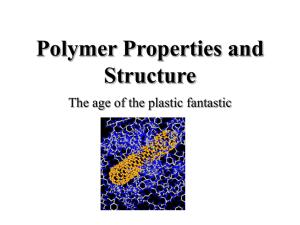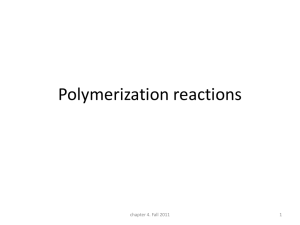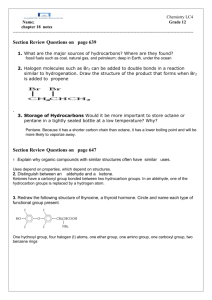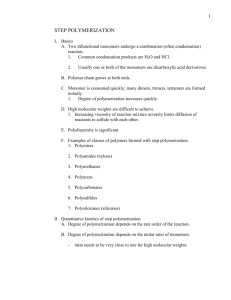Polymer Synthesis: Nylon-6,10 & Polystyrene Lab Discussion
advertisement
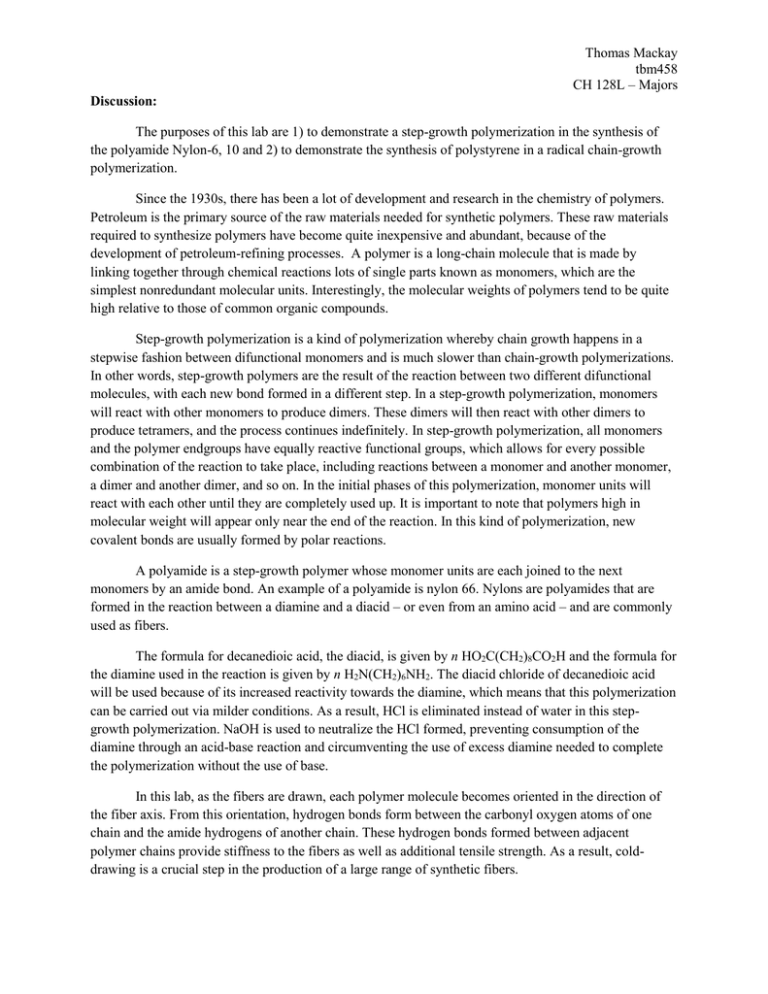
Thomas Mackay tbm458 CH 128L – Majors Discussion: The purposes of this lab are 1) to demonstrate a step-growth polymerization in the synthesis of the polyamide Nylon-6, 10 and 2) to demonstrate the synthesis of polystyrene in a radical chain-growth polymerization. Since the 1930s, there has been a lot of development and research in the chemistry of polymers. Petroleum is the primary source of the raw materials needed for synthetic polymers. These raw materials required to synthesize polymers have become quite inexpensive and abundant, because of the development of petroleum-refining processes. A polymer is a long-chain molecule that is made by linking together through chemical reactions lots of single parts known as monomers, which are the simplest nonredundant molecular units. Interestingly, the molecular weights of polymers tend to be quite high relative to those of common organic compounds. Step-growth polymerization is a kind of polymerization whereby chain growth happens in a stepwise fashion between difunctional monomers and is much slower than chain-growth polymerizations. In other words, step-growth polymers are the result of the reaction between two different difunctional molecules, with each new bond formed in a different step. In a step-growth polymerization, monomers will react with other monomers to produce dimers. These dimers will then react with other dimers to produce tetramers, and the process continues indefinitely. In step-growth polymerization, all monomers and the polymer endgroups have equally reactive functional groups, which allows for every possible combination of the reaction to take place, including reactions between a monomer and another monomer, a dimer and another dimer, and so on. In the initial phases of this polymerization, monomer units will react with each other until they are completely used up. It is important to note that polymers high in molecular weight will appear only near the end of the reaction. In this kind of polymerization, new covalent bonds are usually formed by polar reactions. A polyamide is a step-growth polymer whose monomer units are each joined to the next monomers by an amide bond. An example of a polyamide is nylon 66. Nylons are polyamides that are formed in the reaction between a diamine and a diacid – or even from an amino acid – and are commonly used as fibers. The formula for decanedioic acid, the diacid, is given by n HO2C(CH2)8CO2H and the formula for the diamine used in the reaction is given by n H2N(CH2)6NH2. The diacid chloride of decanedioic acid will be used because of its increased reactivity towards the diamine, which means that this polymerization can be carried out via milder conditions. As a result, HCl is eliminated instead of water in this stepgrowth polymerization. NaOH is used to neutralize the HCl formed, preventing consumption of the diamine through an acid-base reaction and circumventing the use of excess diamine needed to complete the polymerization without the use of base. In this lab, as the fibers are drawn, each polymer molecule becomes oriented in the direction of the fiber axis. From this orientation, hydrogen bonds form between the carbonyl oxygen atoms of one chain and the amide hydrogens of another chain. These hydrogen bonds formed between adjacent polymer chains provide stiffness to the fibers as well as additional tensile strength. As a result, colddrawing is a crucial step in the production of a large range of synthetic fibers. The reaction of an acid chloride and a primary amine requires two moles of the amine, one to form the amide and the other to neutralize the HCl byproduct. The mechanism for this reaction consists of nucleophilic addition of the amine to the carbonyl carbon atom, followed by a proton transfer to yield a tetrahedral addition intermediate that can lose a proton and directly eliminate chloride to form the products. In this reaction, however, NaOH will be used to neutralize the HCl formed as a byproduct. In the chemical industry, the chief reaction of alkenes is chain-growth polymerization. There are a few kinds of chain-growth polymerization, namely anionic, cationic, and radical. This kind of polymerization consists of sequential addition reactions, either to unsaturated monomers or monomers that have other reactive functional groups. In other words, it is a kind of polymerization whereby monomers are joined together without the loss of atoms. In chain-growth polymerization, endgroups have reactive intermediates that will only react with a monomer. The reactive intermediates in this kind of polymerization can range from carbanions, radicals, organometallic complexes, and carbocations. In contrast to step-growth polymerizations, because chain-growth polymers form exclusively from the ends and monomers do not react with themselves, the growth of a polymer chain will take place in a linear fashion throughout the entire polymerization. Diacyl peroxides are used as initiators for radical chain-growth polymerizations, because they decompose upon heating. The first step is the hemolytic cleavage of the weak oxygen-oxygen peroxide bond to produce acyloxy radicals. Next, every acyloxy radical will decompose to produce both an aryl radical and carbon dioxide. The dissociation of the initiator will produce a radical that will then react with the double bond of a monomer. When the radical polymerization has been initiated, the chain will continue to propagate through successive additions of more monomer units. The initiator in this lab is tert-butyl peroxybenzoate, which starts the reaction via thermal decomposition. The radical end of a growing polymer chain will abstract a hydrogen atom from the carbon atom adjacent to the end of another polymer radical. Through a process called disproportionation, this will then produce both an unsaturated and saturated molecule. In more precise terms, disproportionation is a termination process in which a hydrogen atom is abstracted from the beta position of the propagating radical of one chain by the radical endgroup of another chain. The mechanism of radical chain-growth polymerization has three steps. The first step involves initiation, whereby radicals will form from nonradical compounds. The next step involves propagation, whereby the reaction of a radical and a molecule will produce a new radical. The third and final step involves chain termination, whereby radicals are destroyed. Conclusion: Polystyrene was formed. Its identity can be verified through a melting point test, which would occur in the range between 86 and 91 °C. Additionally, based on its appearance, polystyrene is a hard, stiff, and transparent synthetic resin. The polyamide Nylon-6, 10 – a white, fiber-like material – was successfully formed and stretched into a nylon rope of approximately 50 feet.

![CHEE_392_-_Words_to_know-Processing[1] - P](http://s3.studylib.net/store/data/009652514_1-54ca9a81dd105bea22c19783eb204240-300x300.png)
